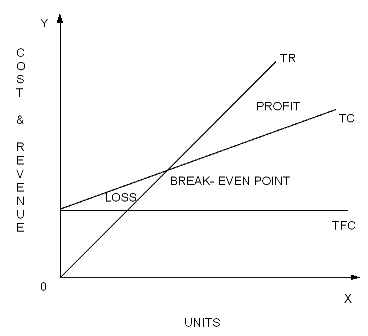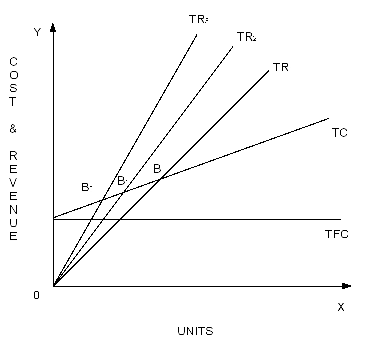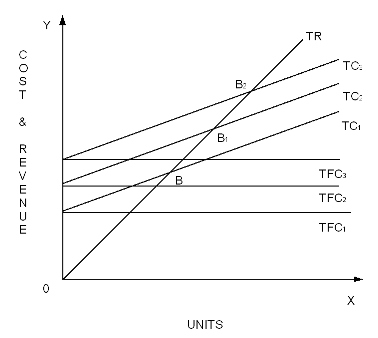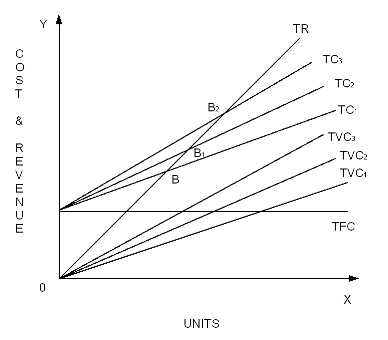Break- Even Analysis
MICROECONOMICS

|
BREAK- EVEN ANALYSIS |

|
Introduction |
Break- Even point is a very significant concept in Economics and business, especially in Cost Accounting. Break- Even point is a point where the cost of production and the revenue from sales are exactly equal to each other; which means that the firm has neither made profits nor has incurred any losses. The Break- Even Analysis is also known as the Cost- Volume- Profit Analysis and is used to study the relationship between total cost, total revenue, profits and losses. It also helps to determine that level of output which is required to cover the operating costs of a business.
}}
| Concept of Break- Even Analysis |
Break- Even analysis is a concept used very widely in the production management and costing. It is an analytical tool which helps the firm to identify that level of sale where it will cover its cost of production. Any sale over and above the break- Even Point will accrue profits to the firm, while any sales less than it would put the firm into losses.The Break- Even Point shows the price at which the firm makes neither profit nor loss.
Symbolically, in the equation form, the break-even point (in terms of Unit Sales (X)) can be directly computed in terms of Total Revenue (TR) and Total Costs (TC) as:
TR = TC
P x X = TFC + V x X
P x X — V x X = TFC
(P — V) x X = TFC
X = TFC / P — V
where TFC is Total Fixed Costs, P is Unit Sale Price, and V is Unit Variable Cost. In other words, if we multiply Unit Sales (X) with the Unit Sale Price (P) we will get the sales revenue amount. The break-even sales can also be measured by dividing fixed costs by Contribution Margin Ratio, i. e.
X = TFC / C
where C is Contribution Margin Ratio. The Contribution Margin Ratio shows the contribution towards the recovery of fixed operating costs, i. e.
X = P — V / P x 100
| SAQ |
If a firm X has fixed operating cost of Rs. 5000, the per unit price of the commodity is Rs. 10 and if the unit variable cost of production is Rs. 5, what will be its break- even sales in units?
| Graphical presentation of the concept |
| Factors influencing Break- Even Point |
1. Changes in Price
Changes in price affect the total revenue from sales and hence the break- even point. An increase in price will prepone the break- even point while a fall in price postpones it. This can be explained with the help of the following diagram:
In this diagram, an increase in price has brought about a shift in the TR curve and has preponed the break even point. The converse is true in case of a fall in the price of the commodity.
| SAQ |
If a firm X in the example solved above finds a rise in price to Rs. 12 what will be its break- even sales and if the price falls to Rs. 6, what will the break- even sales be?
2. Changes in fixed cost
An increase in the fixed cost increases the break- even point while a fall in the fixed cost will reduce the break- even point.
In this diagram, an increase in fixed cost has brought about a shift in the TC curve and has increased the break even point. The converse is true in case of a fall in the fixed cost.
| SAQ |
If a firm X in the example solved above finds a rise in the fixed cost to Rs. 7000 what will be its break- even sales and if the fixed cost falls to Rs. 3000, what will the break- even sales be?
3. Changes in variable cost per unit
An increase in the variable cost per unit increases the break- even point while a fall in the variable cost will reduce the break- even point.
In this diagram, an increase in variable cost has brought about a shift in the TC curve and has increased the break even point. The converse is true in case of a fall in the variable cost.
| SAQ |
If a firm X in the example solved above finds a rise in the variable cost per unit to Rs. 8 what will be its break- even sales and if the variable cost per unit falls to Rs. 3, what will the break- even sales be?
| Limitations of Break- Even Analysis |
- For the break- even point to be counted, all costs need to be clearly categorized in fixed and variable costs, which may not be possible every time.
- For the multiple- product or joint- product operations, it is difficult to apply the break- even analysis. on needs to ascertain the costs to each product> hence the analysis is applicable only for single product.
- The computation of break- even point is based on the historical information. If this information is not relevant, the analysis can not be applied usefully.
| Significance of Break- Even Analysis |
The break- even analysis helps us to determine the levels of sales necessary to meet all the operating costs. With the estimates of revenue and costs, we can forecast the profits. One can also appraise the effects of change in price, fixed costs and variable cost on sales volume, total cost and total revenue and in turn, on the break- even point. One can compare the profit earning capacities of different firms. It can also bring out the significance of capacity utilization for achieving economy.

|
Results |
1. Break- Even point is a point where the cost of production and the revenue from sales are exactly equal to each other.
2. The firm has neither made profits nor has incurred any losses.
3. Break- Even analysis is a concept used very widely in the production management and costing.
4. An increase in price will prepone the break- even point while a fall in price postpones it.
5. An increase in the fixed cost increases the break- even point while a fall in the fixed cost will reduce the break- even point.
6. An increase in the variable cost per unit increases the break- even point while a fall in the variable cost will reduce the break- even point.

|
Key Terms |

|
References and Bibliography |
- Pindyck, Rubinfeld and Mehta - Microeconomics, 7th edition
- P.A. Samuelson,’A note on the Pure Theory of Consumers’ Behaviour’, Econometrica NS.5(1938)
- Varian, H. (1992) Microeconomic Analysis, Third edition, New York: Norton, Section 8.7







